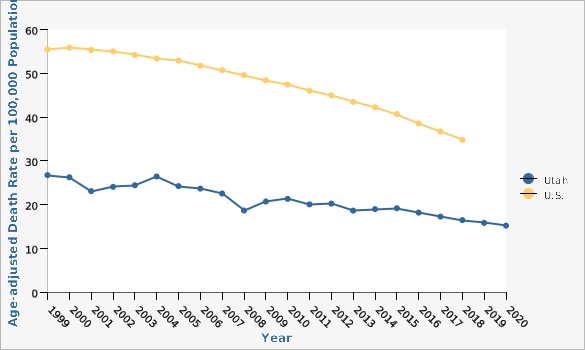Why Is This Important?
Lung cancer is the leading cause of cancer-related death in both Utah and the U.S. Because lung cancer symptoms often do not appear until the disease is advanced, early detection of this cancer is difficult.
Cigarette smoking is the single most important risk factor for lung cancer. There are more than 80 carcinogens in cigarette smoke. Other risk factors include occupational or environmental exposure to secondhand smoke, radon, asbestos (particularly among smokers), certain metals (chromium, cadmium, arsenic), some organic chemicals, radiation, air pollution, and medical history of tuberculosis. Genetic susceptibility also plays a contributing role in the development of lung cancer, especially in those who develop the disease at a younger age.Lung Cancer Deaths by Year, Utah and U.S., 1999-2020 |
Data Sources
- Utah Death Certificate Database, Office of Vital Records and Statistics, Utah Department of Health
- Population Estimates: National Center for Health Statistics (NCHS) through a collaborative agreement with the U.S. Census Bureau, IBIS Version 2020
- U.S. Cancer Statistics: WONDER Online Database. United States Department of Health and Human Services, Centers for Disease Control and Prevention and National Cancer Institute. Accessed at [http://wonder.cdc.gov/cancer.html]
Data Notes
ICD codes used to define lung cancer: C33-C34
Age-adjusted to U.S. 2000 standard population.[[br]]Risk Factors
Cigarette smoking is the most important risk factor for lung cancer. Other risk factors include occupational exposures such as radon and asbestos and indoor and outdoor pollution, including environmental tobacco smoke.How Are We Doing?
The age-adjusted lung cancer mortality rate in Utah has generally been significantly lower than the U.S. rate. The age-adjusted lung cancer mortality rate in Utah significantly decreased from 26.4 deaths per 100,000 persons in 2004 to 15.2 deaths per 100,000 persons in 2020.
Lung cancer mortality rates in Utah vary by geography. For combined years 2018-2020, the Southeast Local Health District had the highest lung cancer death rate in the state at 24.6 deaths per 100,000 persons. Conversely, Utah County Local Health District had the lowest lung cancer death rate in the state at 11.0 deaths per 100,000 persons. Geographical distribution of lung cancer deaths can also be viewed in more detail at the Utah Small Area level (see additional data views).
For combined years 2018-2020, those of Hispanic ethnicity had a significantly lower rate of lung cancer deaths (11.52 per 100,000 persons) compared to those of non-Hispanic ethnicity (16.2 deaths per 100,000 persons). When looking at lung cancer mortality rates by race for combined years 2016-2020, those who identified as Pacific Islander and Black had significantly higher lung cancer death rates (22.6 deaths per 100,000 persons and 19.8 deaths per 100,000 persons, respectively) compared to those of other racial groups.What Is Being Done?
Since nearly 90% of lung cancer deaths are attributed to smoking, public health programs aim to reduce lung cancer by focusing on tobacco prevention and control. The Utah Tobacco Prevention and Control Program coordinates efforts to accomplish the following four goals: prevent youth from starting to use tobacco, help tobacco users quit, eliminate exposure to secondhand smoke, and reduce tobacco-related health disparities.
The Utah Comprehensive Cancer Control program (CCC) and its affiliated coalition, the Utah Cancer Action Network (UCAN), work together with state and local partners to reduce the burden of cancer in Utah. Their mission is to lower cancer incidence, morbidity, and mortality in Utah through collaborative efforts directed toward cancer prevention and control. As a result, they support community-based strategies around food security, healthy neighborhoods, access to health care, and financial toxicity in order to prevent cancer; detect cancer early; and improve the lives of cancer survivors, caregivers, and their families.Healthy People Objective: Reduce the lung cancer death rate
U.S. Target: 45.5 deaths per 100,000 population
Date Indicator Content Last Updated: 04/14/2022

